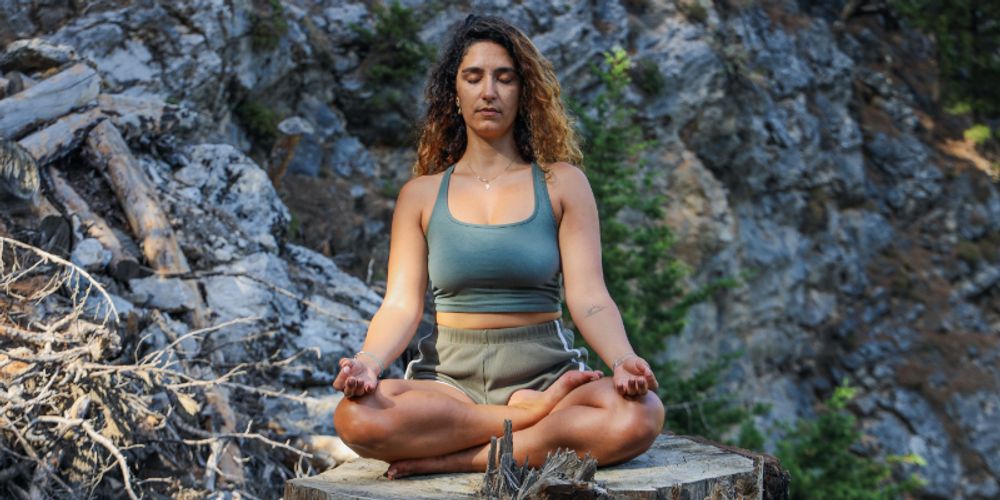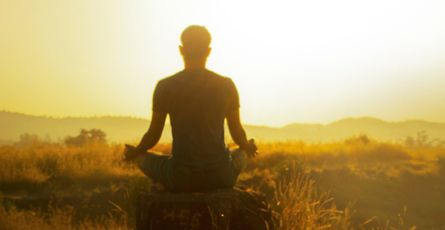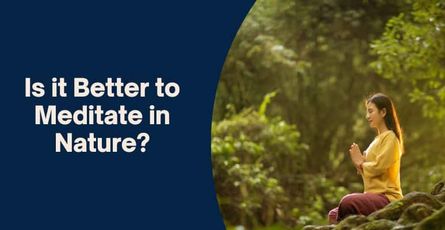Why Meditate With Your Palms Up Or Down?
-
 Dan Rivers
Dan Rivers
- 11 March 2023

If you are just starting out with meditation and want to get everything right, you may also be worried about getting it perfect.
Having everything perfectly in place to make sure you experience the fruits of meditation. Right? There’s no evidence that being in a certain position will make the meditation more or less.
But it can help you since it can have a psychological effect on you, making you overthink less the meditation you’re doing, and thus, leading to a more fulfilled experience.
When it comes to having the palms of our hands up or down, you’ve likely seen many meditators put their palms up.
Some teachers even instruct this to their students. But if keeping your hands up helps you to stay in the
present moment, in complete silence and stillness, you should, by all means, continue to do that. The same can be said about meditating with your palms down. Now, from a spiritual perspective, it can make more sense to meditate with the palms up.
Meditating With Palms Up
From a spiritual point of view, it often resembles surrendering, and from a religious point of view, it can be a form of prayer. Almost as if asking to connect with a supernatural source. Yogis on the other hand many times put their hands up to enhance their posture.
Posture is important for meditation since moving can disrupt your focus and if you’re uncomfortable throughout the entire meditation, meditation can end up making you feel exhausted rather than energized. It’s frustrating when the meditation has the opposite intended effect.
It makes us feel as if our efforts were futile, even though at times this is just part of the process of getting it right. After all, meditation can many times be approached scientifically through a system of trial and error to make it work for you.
For those that see meditation from a spiritual view, they may also experience benefits pertaining to their chakras when meditating, which are also known as energy centers throughout our body, and help the free flow of energy throughout the body.
However, we do that regardless when we meditate and bring our thoughts and mind together, as well as let thoughts flow. Thoughts feed off of energy, but not every thought you get is yours, as much as your mind makes you feel otherwise.
Some report feeling more relaxed when they put their hands up, as it can also be seen as a way of reciprocating, as in giving away energy and getting energy back in return.
Meditating With Palms Down
When we meditate with our palms down, however, we focus on the inwards, however. This usually is what’s more in tune with meditation, as focusing inwards we can help to quiet the mind.
From the point of view that to get a hold of the external we first need to focus on the internal, it makes sense to start meditation practices with palms down, and then with palms up.
But in the grand scheme of things, it doesn’t matter, since keeping your focus on meditation is what will determine whether it’s a successful experience or one we feel is wasted.
Mastery will come regardless, so long as we are consistent, there are no guidelines on whether to keep the palms up and down.
But one direct benefit I can think of when sitting with the palms down is if you are meditating in nature, (as many monks do) and you’re sitting on the grass, and you want to engage your senses with nature, meditating with your palms down, especially on the grass is a way to connect with the earth.
There isn’t going to be an answer that serves everyone, since it’s all a process of trial and error and nothing says you can’t combine the two or switch every so often.
But depending on your belief systems, and it makes more sense to keep the palms up or down, you should put them according to what you feel is right for you.
If you are confused and want to get the meditation right, test and see if the position of the hand has any ability to keep you more focused and still as you focus on your breath.
This personally hasn’t made a difference for me but with yourself, you’d need to experiment to find what works for you. I personally never pay attention to how my hands are placed with meditation.
However, if you are learning meditation from someone that you look up to that keeps their palms in a certain direction, and you wish to attain similar results, you’ll likely benefit from keeping your palms in the same position.
That way you’ll be guided into a more straightforward path with meditation, and having a sense of direction can help anyone, especially those who are starting out.
The incentive to continue a meditation isn’t as strong if we don’t know for sure we are making progress.
But progress takes time to materialize, therefore, it’s important to trust the process. And some trust the process more when they learn from someone that’s been in their shoes.
One case where posture can be helpful is if it alters your breathing in a way that’s beneficial to you.
Since, at times, with certain meditations, we are taught certain meditation techniques that are done in conjunction with keeping the palms up. And that may be the only path to faster deep relaxation.
The faster we get into this relaxed state, the easier we make the meditation for ourselves. This is crucial for beginners to have an incentive to continue the practice by seeing progress quicker. You may even find that you’re not able to fully relax until your palms are up or down.
Getting into a meditative state is hard, but if you’re able to achieve it without compromising your comfort, regardless of the position of your hands, you will be getting ahead of most meditators. Since it takes time to enter a profound territory with the practice.
One thing is certain, you can’t go wrong if you choose to incorporate a comfortable posture in combination with a breathing technique that you’re able to stay consistent with.
The less movement the better, so the sooner you set yourself up for success and find what works, the more likely you are to transition from a beginner to an intermediate, to an advanced meditation practitioner.
Don’t be a perfectionist though. Allow yourself to make mistakes since the trial and error process of meditation is worth it and can be fun if you teach yourself to fall in love with the practice.
Your face also doesn’t have to be perfectly aligned to a certain position and neither do your palms and while these can have an impact on your meditation, evidence suggests it has a minor effect on the meditation experience. Don’t be fixated on the small things only to get it perfect.


